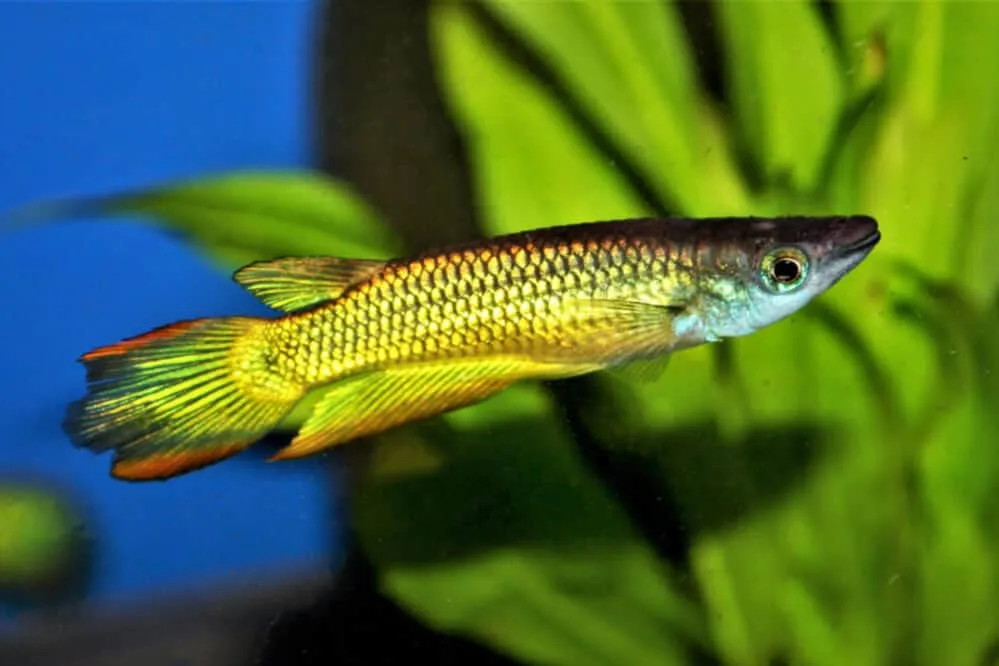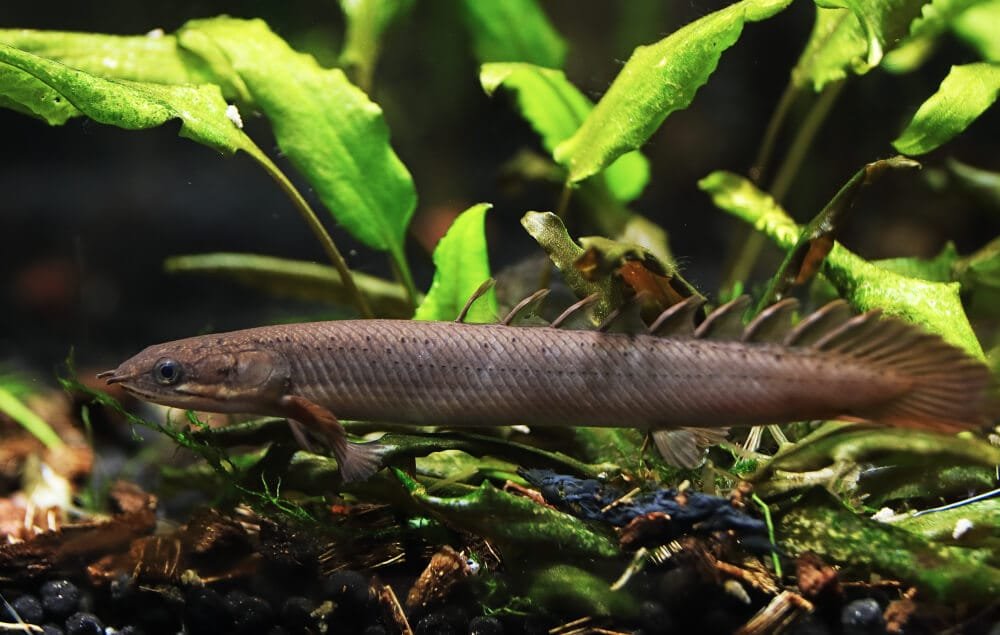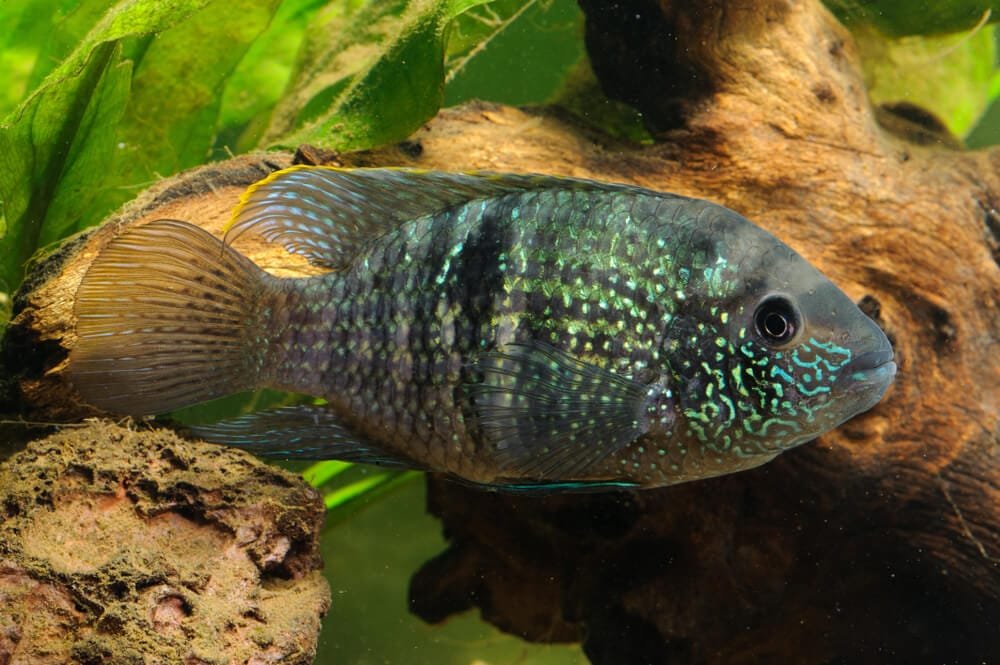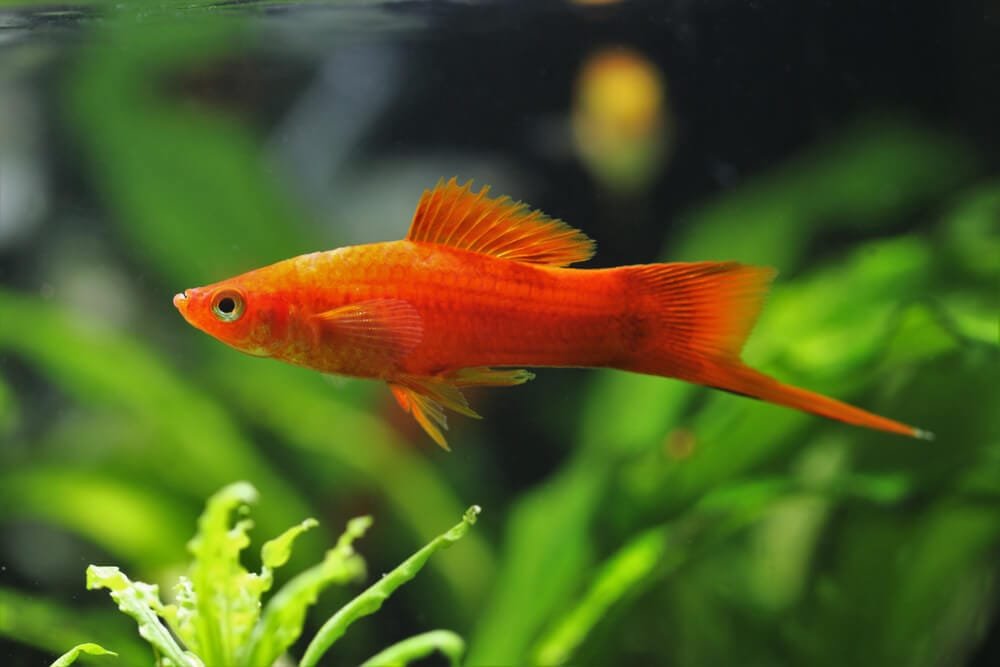Golden Wonder Killifish, known for its bright yellow body with black spots and a black stripe running along its sides, is a beautiful addition to your tank aquarium. This fish is native to the freshwater rivers of India and Srilanka.
Many tank aquarium enthusiasts find it fascinating to keep due to its adaptability and easy-care level. This fish is a carnivore and its diet consist mainly of live or frozen foods such as bloodworms, brine shrimp, and daphnia.
It will also accept dried foods such as flakes or granules, but these should not form the main part of its diet. The fish is a peaceful species and can be kept with other peaceful fish of a similar size.
Although this fish species is not strict schooling, it can do well when kept in a group of 4 other fish species. Having compatible tank mates for golden wonder killifish include having a more active and interesting aquarium, as well as providing companionship for the fish.
This article provides a list of the best possible tank mates for the Golden Wonder Killifish.
1. German Blue Ram
Size: 2-4 Inches
Min Tank Size: 20 Gallons
Temperament: Peaceful
Diet: Opportunistic omnivore
Care Level: Beginner

The German blue ram is a peaceful fish that is an excellent tank mate for golden wonder killifish. They will not bother each other.
In anything, the German blue ram may even help to keep the golden wonder killifish tank clean by eating some of the algae that grow on the glass and decorations.
The German Blue Ram is a striking freshwater fish that is native to the rivers and streams of South America. The body of the German Blue Ram is elongated and compressed, with a pointed head and large eyes. The back and sides of the fish are a beautiful blue color, while the belly is white. There are also black spots on the body and fins.
The German Blue Ram is a peaceful fish that does well in a community aquarium. This small, freshwater fish is not overly aggressive and will get along with other peaceful fish. They do best in an aquarium that is at least 20 gallons in size and has plenty of hiding places.
The German Blue Ram is a timid fish, so it is important to provide plenty of covers. It also loves to explore, making it very crucial to include rocks in the aquarium.
This is an omnivorous fish and does well on a diet of flakes, pellets, and live or frozen foods. They also enjoy eating algae and other plant matter.
It is important to provide a varied diet to keep the German Blue Ram healthy and happy. The German Blue Ram is a relatively easy fish to care for, making it a good choice for beginner aquarium enthusiasts. With proper care, the German Blue Ram can live for several years in the home aquarium.
2. Cardinal Tetra
Size: 1.25 – 2 inches
Min Tank Size: 20 Gallons
Temperament: Peaceful and playful
Diet: Omnivorous
Care Level: Easy

The Cardinal Tetra will be a fine tank mate for the Golden Wonder Killifish. These two fish have similar care requirements and will do well together in a freshwater aquarium. The Cardinal Tetra is a peaceful fish that will do well in a community aquarium. These fish are schooling fish and do best when kept in groups of six or more.
The Cardinal Tetra (Paracheirodon axelrodi) is a freshwater fish native to the Orinoco Basin in South America. It is a popular aquarium fish and has been introduced to many habitats around the world.
The Cardinal Tetra is a small fish and can grow to a maximum length of 3 inches. It is a member of the Characidae family and is closely related to the Neon Tetra (Paracheirodon innesi).
The Cardinal Tetra is a brightly-colored fish, with a blue-violet body and bright red fins. The red coloration extends from the base of the tail to the middle of the body. The belly and underside of the tail are silver-white. There are two vertical black stripes on the body, one on each side.
The Cardinal Tetra is an omnivorous fish and will eat a variety of foods. In the wild, their diet consists of small insects, crustaceans, and other small invertebrates. In the aquarium, they will eat most types of commercial fish food, as well as live foods.
3. Otocinclus Catfish
Size: Max. 2 Inches
Min Tank Size: 10 Gallons
Temperament: Peaceful
Diet: Herbivorous
Care Level: Beginner

The Otocinclus Catfish is a peaceful, bottom-dwelling scavenger that is an excellent addition to any freshwater aquarium. This hardy little fish is native to South America and is a member of the Loricariidae family.
The Otocinclus Catfish is also known as the Dwarf Suckermouth, Oto Cat, or Algae Eater. It is a small fish, only reaching a maximum size of 2 inches (5 cm).
The fish comes in brown or black in coloration and have a white or cream-colored belly. The Otocinclus Catfish has a flattened body and a sucker mouth that they use to attach to rocks and wood. They also have two pairs of barbels that they use to find food.
The Otocinclus Catfish is a peaceful community fish that does well in a tank with other small, peaceful fish. It is a bottom-dweller and this helps it to keep away from trouble.
This makes them ideal tank mates for the Golden Wonder Killifish. They are shy fish and do best in a tank with plenty of hiding places.
The Otocinclus Catfish is a scavenger and will help to clean up algae and other detritus in the aquarium. This is crucial for maintaining the tank’s ecosystem. This fish also loves to clean the glass.
They are not finicky eaters and will accept most aquarium foods, but they do require a diet that is high in vegetable matter. This is because they are herbivorous.
Offer them a variety of vegetables, algae wafers, and brine shrimp to ensure proper nutrition. They especially love fresh vegetables like Zucchini.
The Otocinclus Catfish is a hardy fish that is relatively easy to care for. They are tolerant of a wide range of water conditions and do not require special care.
They are, however, sensitive to changes in water quality and should only be added to an established aquarium. The Otocinclus Catfish is also susceptible to ich and other diseases, so quarantining new fish is always recommended.
4. Dwarf Cichlids
Size: 4 inches
Min Tank Size: 20 Gallons
Temperament: Peaceful
Diet: Omnivorous
Care Level: Easy

The dwarf cichlid is an excellent tank mate for the golden wonder killifish. Both fish are small, peaceful, and easy to care for. The dwarf cichlids are native to Central and South America and come in a variety of colors and patterns.
Both the golden wonder killifish and the dwarf cichlids get along well together. Generally, they will add some beautiful color and interest to your aquarium.
Dwarf cichlids are a type of freshwater fish that are popular in the aquarium trade. Dwarf cichlids are typically smaller than other cichlids, reaching a maximum size of about 4 inches (10 cm).
Most dwarf cichlids are peaceful fish, although there are a few species that can be aggressive.
Dwarf cichlids are easy to care for and are not demanding in terms of water quality.
In addition, they can live in a wide range of water parameters. Dwarf cichlids are omnivorous and will eat most types of aquarium foods, including flakes, pellets, and live foods.
Dwarf cichlids are social fish and do best in groups. They should be kept with other peaceful fish of similar size. When kept in groups, dwarf cichlids will often form pairs or small harems.
Something else to note about dwarf cichlids is that they are easy to breed and make excellent parents. The fry (baby fish) is small and can be difficult to raise, so it is best to leave breeding to the experts.
If you are looking for a peaceful, easy-to-care-for freshwater fish for your golden wonder killifish aquarium, then a dwarf cichlid might be the perfect choice for you!
5. Corydoras
Size: 2.4 inches
Min Tank Size: 20 Gallons
Temperament: Peaceful
Diet: Omnivorous
Care Level: Beginner

The Corydoras is a fish that is often recommended to beginning aquarium keepers because it is gentle. It can also coexist in an aquarium with other fish of the same temperament.
The Corydoras is a species of fish that lives in freshwater and is a member of the family Callichthyidae, specifically the subfamily Corydoradinae. Its homeland is South America, and the Amazon, Paraguay, Uruguay, and Araguaia rivers.
This aquarium fish goes by several other names, including bronze corydoras, golden corydoras, and green corydoras, among others. This catfish spawns in the aquarium, and the young can be fed a diet consisting of live foods as well as commercial feeds designed specifically for fry.
The Corydoras is a little species of fish that can reach a maximum length of about 6 centimeters (2.4 in). It has black markings on the head and fins, and its body is either brown or greenish-brown in color.
The spines that are found on the dorsal and pectoral fins are used for defense. This fish species also has barbels located around the mouth, which helps the fish locate food.
The Corydoras is a calm species of fish that swims in schools when in its natural environment. When in an aquarium, it is highly recommended to place it with a minimum of six other fish that won’t disrupt the serene environment
It is an omnivorous species, meaning that it will consume a wide range of foods. This can include alive or frozen fish food as well as algae and plant matter.
Corydoras fish are known for their resilience and the ease with which they may be maintained. This makes it a common choice for beginning aquarists.
6. Rummy Nose Tetra
Size: 1.75-inches
Min Tank Size: 25 Gallons
Temperament: Peaceful and Timid
Diet: Omnivore
Care Level: Beginner

The Rummy Nose Tetra, also known scientifically as Hemigrammus rhodostomus, is a schooling fish that is known for its calm demeanor. This fish originates from the pristine waters of the Orinoco River Basin in South America.
It is a stunning fish that can be identified quickly thanks to its brilliantly red nose and its remarkable black vertical stripes. The Rummy Nose Tetra is a common aquarium fish that thrives best in an aquarium with plenty of plants and other fish that don’t bother it too much.
Rummy Nose Tetras are not picky when it comes to the characteristics of the water in which they live and can thrive in a diverse array of water conditions. Temperatures between 76- and 86 degrees Fahrenheit and a pH ranging from 6.0 to 7.5 are appropriate for this fish to thrive well.
Furthermore, they are not the pickiest eaters. Nonetheless, they do best on a diet that consists of live, frozen, or freeze-dried meals served in little portions.
Rummy Nose Tetras are highly social fish that thrive when kept in groups of at least six fish. In general, they are not aggressive, although they might bite the fins of other fish in the aquarium if they have long fins.
Also, they are not suited for community aquariums with fish of greater size or one that is more aggressive. When maintained together, Rummy Nose Tetras will organize themselves into a social structure that features a clear pecking order.
The fish that hold the dominating position will be the largest and most vividly colored, while the fish that hold the subordinate position will be smaller and less vividly colored.
It shouldn’t be too difficult to raise Rummy Nose Tetras in your home tank. They are egg layers, and it takes between 24 and 48 hours for the eggs to hatch after being laid.
Because of their diminutive size, the fry will require extremely minute foods for the first several weeks of their lives. They will grow very quickly once they reach the size when they can consume baby brine shrimp or other similarly sized live meals.
7. Celestial Pearl Danios
Size: 2 Inches
Min Tank Size: 20 Gallons
Temperament: Peaceful
Diet: Omnivore
Care Level: Beginner

A stunning kind of freshwater fish found only in Myanmar, the Celestial Pearl Danio is endemic to the country. In addition to its more common name, the Galaxy rasbora, this species belongs to the family Cyprinidae.
The fish lives between three and five years and has a coloration consisting of iridescent blue and white. Its lifespan is between three and five years.
It is a calm fish that thrives in groups of at least six and works well in a community tank with other peaceful fish. The ideal way to keep this fish is in large groups.
The Celestial Pearl Danio is an omnivore that will consume a wide variety of meals, such as those that are live, frozen, and in a flake form. Because of its omnivorous nature, this fish is very easy to care for.
The Celestial Pearl Danio is a stunning and tranquil fish that is excellent for keeping in a communal aquarium due to these qualities. The fish lives between three and five years and has a coloration that is iridescent blue and white.
Its lifespan is between three and five years. In general, the Celestial Pearl Danio is an excellent choice to consider if you want an attractive fish that requires little care and attention.
8. Peppered Cory Catfish
Size: 2-3 inches
Min Tank Size: 10 Gallons
Temperament: Peaceful
Diet: Omnivore
Care Level: Beginner

Because of its calm demeanor and voracious appetite for food scraps, the Cory Catfish is a popular choice to keep as a pet fish. As a result of the fish’s ability to thrive in a diverse array of water conditions, it is an excellent choice as a tankmate for Golden wonder killifish.
The fish is a gregarious organism that will frequently swim in large schools with other fish. Plus, the Cory Catfish is a resilient fish that requires little attention from its owner.
This fish species lives in freshwater and is a member of the genus Corydoras. It originates from South American countries such as Brazil, Peru, and Uruguay.
The name of this fish is inspired by its scientific name, Corydoras paleatus. The Cory Catfish can have a brown or black body, and it is covered in white dots all around.
The Cory Catfish is a docile species of fish that is frequently kept as a pet due to its lack of aggression. The fish lives in the sediment and is well-known for its propensity of scavenging for food.
Cory Catfish can locate food via the barbels that are located on its chin. The Cory Catfish is an omnivore species of fish, meaning it will consume both plant matter and animal matter in its diet.
The Cory Catfish is a resilient fish that requires little attention from its owner. The fish can adapt to a diverse variety of environmental variables within the water and is able to survive in both fresh and salt water.
The Cory Catfish is a favorite among aquarists and is frequently employed to clean the substrate at the tank’s bottom.
Frequently Asked Questions
What are the care requirements for the golden wonder killifish in a home aquarium?
To successfully keep golden wonder killifish in a home aquarium, you will need a tank that is at least 20 gallons in size. However, a 30-gallon tank will be best ideal if you intend to add tank mates. Plus, since they are small, freshwater fish, they can do well in nano aquariums.
Since this fish species prefers an environment with heavy forestation, it is a good idea to add floating aquarium plants to its aquarium. Also, add dark and sandy substrate to the tank.
As for the water, this fish species prefers brackish water. The ideal temperatures should be between 72- and 72 degrees Fahrenheit, and the pH should be between 6.0 and 7.5 PH.
What kind of food does golden wonder killifish consume?
Golden wonder killifish are primarily carnivorous and will consume a wide variety of live meals including several different insects, worms, and crustaceans. They may also take items that have been frozen or freeze-dried.
How frequently do golden wonder killifish require their food to stay healthy?
It is recommended that golden wonder killifish be fed two to three times per day.
How long does the life of a golden marvel killifish typically last?
The golden marvel killifish typically lives for only two to three years on average. They need a variety of foods and it helps to give them food that they can eat in just two minutes.
Is the golden wonder killifish prone to any diseases?
The golden wonder killifish is a hardy fish and it rarely gets diseases, especially when kept in a well-maintained tank that imitates its natural environment. Also, this fish will unlikely get sick when fed a variety of healthy food options.
Nonetheless, this species may still be prone to velvet and bacterial diseases. This can be brought about by things like substrate, plants, decorations, and other fish. For this reason, it is very crucial to clean any items you intend to introduce to your tank.
Can golden wonder killifish eat other fish?
Yes, the golden wonder killifish is a carnivore and has a wide mouth. It can eat anything that fits into its mouth including smaller fishes like Danios and Tetras. It can also eat its young ones. Therefore, it helps to place them separately.
Conclusion
Ultimately, the golden wonder killifish is a very peaceful fish species and can safely be placed in groups of 4 with other fish species. When you keep other fish in the same tank as a Golden Wonder Killifish, you need to pay close attention to the peculiar behaviors and requirements of each species.
The species you select for your aquarium will have a considerable impact on the degree to which your home aquascape is tranquil. You’ll have a much simpler time sustaining a peaceful habitat if you choose larger fish species that are calm and peaceful as tank mates for your golden wonder killifish.
We hope that this article gives you viable choices of tankmates for your golden wonder killifish.






